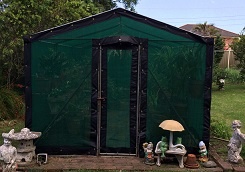 When it comes to gardening, it is important to know that all shade is not created equal. Factors such as season, time of the day, plant age, plant density and canopy composition can affect how the plants are shaded. Understanding these aspects can help you in giving the appropriate care for your shade loving plants.
When it comes to gardening, it is important to know that all shade is not created equal. Factors such as season, time of the day, plant age, plant density and canopy composition can affect how the plants are shaded. Understanding these aspects can help you in giving the appropriate care for your shade loving plants.
Shade is a term to describe the degree of relief from the sun. It blocks the sunlight using any object and the shadow it creates. When growing your shade loving plants, it is crucial to match the degree of shade that the plant needs. Aside from that, you have to consider how much sunlight it can tolerate.
In this blog post, the types of shades are classified into two. These are according to shade density and design. To learn more, here are the 7 types of shade that help grow your shade-loving plants better. Read further below.
According to shade density
There are four types of shade according to the duration of time without sun and shade density. Learn more about these types of shade below.
1. Dense shade
It is typically the area that is located under and around manmade structures. If there are a lot of dense growing evergreen trees, these can also create a dark shade underneath them. Potted plants are ideal to be placed under dense shade.
2. Full shade
Full shade does not necessarily mean “no sun”. Plants that need to be in full shade are those that can survive direct exposure to sunlight for no more than 3 hours each day. The plant should also have filtered sunlight during the rest of the day. Some examples of plants that can survive in full shade are shrubs and ferns.
Full shade is a similar type to dense shade but reduces in different seasons. This type of shade is a good place to grow plants that are tolerant of shades. It can also survive in reflected light.
3. Light shade
Light shade is an area that is laid under tall trees. This is also called dappled shade. Basically, this area is not completely deprived of all light. However, it should not overly lit.
This is the region that receives filtered sunlight during the day. Thus, it is the ideal place to grow shade-loving plants.
4. Part shade or partial sun
This is the type of shade where plants are exposed to the sun for 3 to 6 hours each day. It is preferred to expose the plants to the sun during the cooler hours in the morning and early afternoon.
“Part shade” and “partial sun” are two interchangeable terms. But, there is a small difference between the two terms. Here are as follows:
-
For plants that require partial sun, it needs a few hours of sun exposure to set flowers and fruits. Just remember that it is not as fussy as sun-worshipper plants that require a full-day sun.
-
On the other hand, for plants that need partial shade, it will need some relief from the extreme heat especially during the late afternoon. To do this, you can place the plant where a nearby tree will cast afternoon shade. Aside from that, you can also place it on the east side of any structure or building where it will be blocked from the afternoon sun.
According to design
There are three types of shades according to its design. Read below to learn more.
5. Tunnel house
It is a mini tunnel shade house that is made from wire fencing. It is usually bent into a C-shape. It is also covered with orchard netting. This shade type is portable and easy to store.
A single layer of tunnel house can be used which can create 10-15% shading. You can also double it to 30% shading depending on the plant shading requirement.
Most of the time, tunnel house shading is used to protect young seedlings and seeds especially during germination.
6. Roller mesh
Even sun-loving plants such as tomatoes usually get sunburnt or have cooked skins during hot days. That is why a roller mesh is needed. It is a shade cloth that can be rolled down only during extremely hot days. Using roller mesh can also reduce the chance of having fungal diseases in plants. When it is not needed, you can roll it back up.
7. Shade cloth curtain
Young fruit trees that are planted against a wall or fence usually need a bit of shading particularly during hot summer days. This is because the radiant heat from these walls and fences can cook the stems, leaves, and fruits of the trees.
Under these conditions, a shade cloth curtain can be used. Just attach a single-layer mesh to a trellis using strong pegs. Then hang it like a curtain.
Conclusion
Planning is a vital stage to create a successful shady garden. In order to grow your shade-loving plants better, it is essential to identify the types of shade you are dealing with before planting. This list of shade types will help you make any garden productive even during the hottest days of summer.
Shade-loving plants should be well taken care of using high-quality shade structure. To help you find your perfect shade house, you can contact a trustworthy shade house provider for more details.







